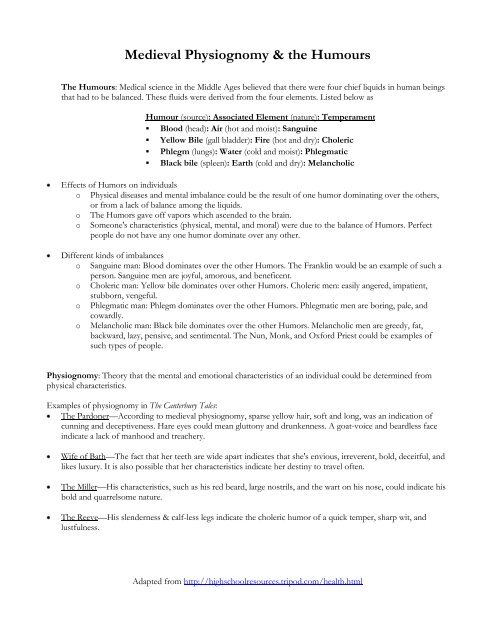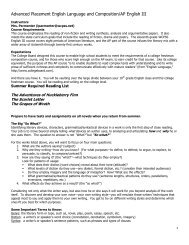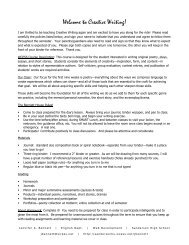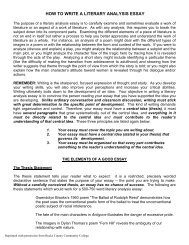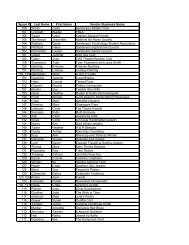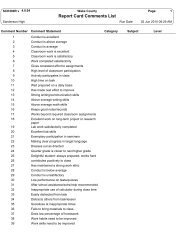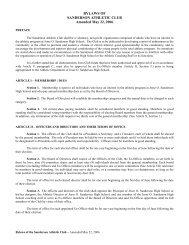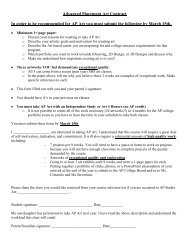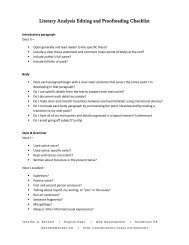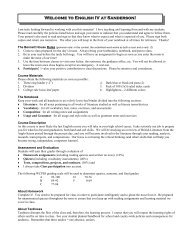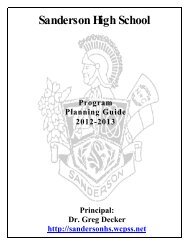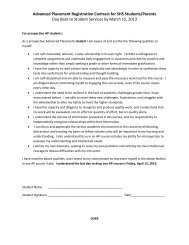Medieval Physiognomy & the Humours - Sanderson High School
Medieval Physiognomy & the Humours - Sanderson High School
Medieval Physiognomy & the Humours - Sanderson High School
Create successful ePaper yourself
Turn your PDF publications into a flip-book with our unique Google optimized e-Paper software.
<strong>Medieval</strong> <strong>Physiognomy</strong> & <strong>the</strong> <strong>Humours</strong><br />
The <strong>Humours</strong>: Medical science in <strong>the</strong> Middle Ages believed that <strong>the</strong>re were four chief liquids in human beings<br />
that had to be balanced. These fluids were derived from <strong>the</strong> four elements. Listed below as<br />
Humour (source): Associated Element (nature): Temperament<br />
Blood (head): Air (hot and moist): Sanguine<br />
Yellow Bile (gall bladder): Fire (hot and dry): Choleric<br />
Phlegm (lungs): Water (cold and moist): Phlegmatic<br />
Black bile (spleen): Earth (cold and dry): Melancholic<br />
Effects of Humors on individuals<br />
o Physical diseases and mental imbalance could be <strong>the</strong> result of one humor dominating over <strong>the</strong> o<strong>the</strong>rs,<br />
or from a lack of balance among <strong>the</strong> liquids.<br />
o The Humors gave off vapors which ascended to <strong>the</strong> brain.<br />
o Someone's characteristics (physical, mental, and moral) were due to <strong>the</strong> balance of Humors. Perfect<br />
people do not have any one humor dominate over any o<strong>the</strong>r.<br />
Different kinds of imbalances<br />
o Sanguine man: Blood dominates over <strong>the</strong> o<strong>the</strong>r Humors. The Franklin would be an example of such a<br />
person. Sanguine men are joyful, amorous, and beneficent.<br />
o Choleric man: Yellow bile dominates over o<strong>the</strong>r Humors. Choleric men: easily angered, impatient,<br />
stubborn, vengeful.<br />
o Phlegmatic man: Phlegm dominates over <strong>the</strong> o<strong>the</strong>r Humors. Phlegmatic men are boring, pale, and<br />
cowardly.<br />
o Melancholic man: Black bile dominates over <strong>the</strong> o<strong>the</strong>r Humors. Melancholic men are greedy, fat,<br />
backward, lazy, pensive, and sentimental. The Nun, Monk, and Oxford Priest could be examples of<br />
such types of people.<br />
<strong>Physiognomy</strong>: Theory that <strong>the</strong> mental and emotional characteristics of an individual could be determined from<br />
physical characteristics.<br />
Examples of physiognomy in The Canterbury Tales:<br />
The Pardoner—According to medieval physiognomy, sparse yellow hair, soft and long, was an indication of<br />
cunning and deceptiveness. Hare eyes could mean gluttony and drunkenness. A goat-voice and beardless face<br />
indicate a lack of manhood and treachery.<br />
Wife of Bath—The fact that her teeth are wide apart indicates that she's envious, irreverent, bold, deceitful, and<br />
likes luxury. It is also possible that her characteristics indicate her destiny to travel often.<br />
The Miller—His characteristics, such as his red beard, large nostrils, and <strong>the</strong> wart on his nose, could indicate his<br />
bold and quarrelsome nature.<br />
The Reeve—His slenderness & calf-less legs indicate <strong>the</strong> choleric humor of a quick temper, sharp wit, and<br />
lustfulness.<br />
Adapted from http://highschoolresources.tripod.com/health.html
The <strong>Humours</strong> and Temperament<br />
The underlying principle of medieval medicine was <strong>the</strong> <strong>the</strong>ory of humours. This was derived from <strong>the</strong> ancient<br />
medical works, and dominated all western medicine up until <strong>the</strong> 19th century. The <strong>the</strong>ory stated that within<br />
every individual <strong>the</strong>re were four humours, or principal fluids - black bile, yellow bile, phlegm, and blood, <strong>the</strong>se<br />
were produced by various organs in <strong>the</strong> body, and <strong>the</strong>y had to be in balance for a person to remain healthy.<br />
Too much phlegm in <strong>the</strong> body, for example, caused lung problems; and <strong>the</strong> body tried to cough up <strong>the</strong> phlegm<br />
to restore a balance. The balance of humours in humans could be achieved by diet, medicines, and by bloodletting,<br />
using leeches. The four humours were also associated with <strong>the</strong> four seasons, black bile-autumn, yellow<br />
bile-summer, phlegm-winter and blood-spring.<br />
The astrological signs of <strong>the</strong> zodiac were also thought to be associated with certain humours. Even now, some<br />
still use words "choleric", "sanguine", "phlegmatic" and "melancholy" to describe personalities.<br />
HUMOUR TEMPER ORGAN NATURE ELEMENT<br />
Black bile Melancholic Spleen Cold Dry Earth<br />
Phlegm Phlegmatic Lungs Cold Wet Water<br />
Blood Sanguine Head Warm Wet Air<br />
Yellow bile Choleric Gall Bladder Warm Dry Fire<br />
Source: http://en.wikipedia.org/w/index.php?title=Four_Temperaments&oldid=461067574
Where are you on <strong>the</strong> circle?<br />
Choleric<br />
Touchy<br />
Restless<br />
Aggressive<br />
Excitable<br />
Chargeable<br />
Impulsive<br />
Optimistic<br />
Active<br />
Melancholic<br />
Moody<br />
Anxious<br />
Rigid<br />
Sober<br />
Pessimistic<br />
Reserved<br />
Unsociable<br />
Quiet<br />
Phlegmatic<br />
Passive<br />
Careful<br />
Thoughtful<br />
Peaceful<br />
Controlled<br />
Reliable<br />
Calm<br />
Even<br />
tempered<br />
Sanguine<br />
Sociable<br />
Outgoing<br />
Talkative<br />
Responsive<br />
Easygoing<br />
Lively<br />
Carefree<br />
Leadership
The Four Temperament Types<br />
Each of <strong>the</strong> four humours corresponded in ancient times to a different personality type.<br />
Sanguine<br />
The sanguine temperament is fundamentally impulsive and pleasure-seeking; sanguine people are<br />
sociable and emotional. They tend to enjoy social ga<strong>the</strong>rings, making new friends and tend to be<br />
boisterous. They are usually quite creative and often daydream. However, some alone time is crucial for<br />
those of this temperament. Sanguine can also mean sensitive, compassionate and thoughtful. Sanguine<br />
personalities generally struggle with following tasks all <strong>the</strong> way through, are chronically late, and tend to<br />
be forgetful and sometimes a little sarcastic. Often, when <strong>the</strong>y pursue a new hobby, <strong>the</strong>y lose interest as<br />
soon as it ceases to be engaging or fun. They are very much people persons. They are talkative and not<br />
shy.<br />
Choleric<br />
The choleric temperament is fundamentally ambitious and leader-like. They have a lot of aggression,<br />
energy and/or passion, and try to instill it in o<strong>the</strong>rs. They can dominate people of o<strong>the</strong>r temperaments,<br />
especially phlegmatic types. Many great charismatic military and political figures were choleric. They like<br />
to be in charge of everything.<br />
Melancholic<br />
The melancholic temperament is fundamentally introverted and thoughtful. Melancholic people often<br />
were perceived as very (or overly) pondering and considerate, getting ra<strong>the</strong>r worried when <strong>the</strong>y could<br />
not be on time for events. Melancholics can be highly creative in activities such as poetry and art--and<br />
can become preoccupied with <strong>the</strong> tragedy and cruelty in <strong>the</strong> world. Often <strong>the</strong>y are perfectionists. They<br />
are self-reliant and independent; one negative part of being a melancholic is that <strong>the</strong>y can get so<br />
involved in what <strong>the</strong>y are doing <strong>the</strong>y forget to think of o<strong>the</strong>rs.<br />
Phlegmatic<br />
The phlegmatic temperament is fundamentally relaxed and quiet, ranging from warmly attentive to<br />
lazily sluggish. Phlegmatics tend to be content with <strong>the</strong>mselves and are kind. They are accepting and<br />
affectionate. They may be receptive and shy and often prefer stability to uncertainty and change. They<br />
are consistent, relaxed, calm, rational, curious, and observant, qualities that make <strong>the</strong>m good<br />
administrators. They can also be passive-aggressive.
More on The <strong>Humours</strong><br />
The humours each had associated physical and mental characteristics; <strong>the</strong> result was a system that was<br />
quite subtle in its capacity for describing types of personality.<br />
Humour Qualities Element Personality<br />
Sanguine hot, moist air Optimistic, red-cheeked, corpulent, irresponsible (Falstaff)<br />
Choleric hot, dry fire Short-tempered, red-haired, thin, ambitious (Hotspur)<br />
Phlegmatic cold, moist water<br />
Sluggish, pallid, corpulent, lazy<br />
(Are any of Shakespeare's characters phlegmatic?)<br />
Melancholic cold, dry earth Introspective, sallow, thin (Richard II, Hamlet)<br />
In addition, different humours could be combined for more complex personality types: cholericsanguine,<br />
phlegmatic-melancholic, and so on.<br />
Source: http://internetshakespeare.uvic.ca/Library/SLT/ideas/order/humours.html


